INTRO:
Ambition is a metaphorical double-edged sword. It can be the drive one needs to achieve success, or it can cause the ruin of those who are not wise to couple ambition with prudence.
With that said, Double Fine intends to make a game with great homage to the music of metal, especially its so-called original form, heavy metal.
For better or worse, Activision, the one who would have published the game if it did not make a decision that was (and still is) disastrous to its public image, disagreed; its reasoning was that it would not have captured a large market. Electronic Arts was next to back Double Fine instead, but the pay-off was not exactly great and the costs were too high.
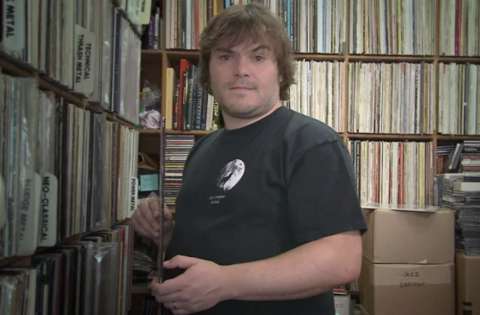
Brütal Legend, of course, did not turn out to be an extremely profitable, neither was it a trend-setting product. It did turn out to be what industry pundits call a “cult classic”, for good reasons which will be elaborated in this review.
PREMISE:
Eddie Riggs is a roadie who likes metal, specifically its original form. (A roadie is the name given to anyone who is an important provider of logistical and technical support for show tours.)
Yet, he has been reduced to helping manage the gigs of a band which practices another form of metal, his dislike for which he will make obvious early on.
However, one day, an accident occurs during a show. Eddie was hurt and he is somehow transported to somewhere else through a supernatural occurrence.
That is the kind of set-up which Double Fine’s writers would use to toss Eddie into a pseudo-fantastical realm which replaces magic with music and souls with fans, among other outrageous differences.
To Eddie though, this new world soon becomes a source of opportunities to indulge himself in his love for metal, as well as meet new friends and find out more about why he so easily fits in.
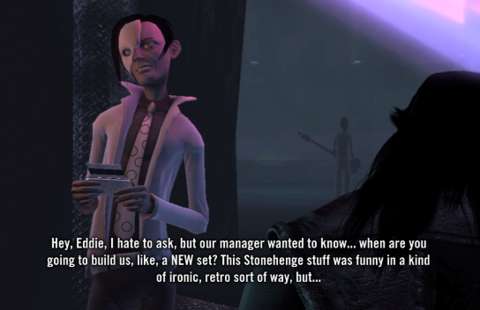
CAMPAIGN DIFFICULTY OPTIONS:
When starting a new playthrough in the campaign, the player is presented with difficulty options – all of which are not explained.
Presumably, this may influence the intelligence of the computer-controlled opponents in the scenarios where the player must overcome an enemy which plays according to the same rules as the player does. In other words, the computer-controlled opponents are not expected to be different from those which the player encounters in “AI practice” matches (more on these later). Yet, in some of these scenarios, the opposing faction fields its assets according to very different rules, so that is not always the case.
How it affects the challenge of the other scenarios is even less clear. Presumably, the enemies which the player would face in these scenarios are tougher and they inflict more damage per hit, but this is hard to tell when the player is playing prudently.
The only way to be sure is to practically replay the story mode with all three options and compare them – but that is only for very ardent fans of the game.
Perhaps the game could have been more transparent in what the difficulty options do, considering that it has been re-released for the computer platform in the years after its debut back in 2009.
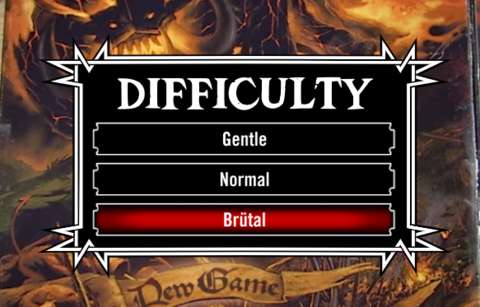
PROFANITY AND GORE OPTIONS:
Early on in the playthrough, the player is directed to make choices for allowing profanity and gore to be in the playthrough. These choices are implemented in the first few prologue scenes itself, which can seem a bit jarring, especially if one considers that the options for gore and profanity can already be accessed through the options menu.
Still, if Double Fine had intended these messages to be funny, then they do seem a bit amusing. For example, what happens afterwards after making the choice to allow profanities and gore is entertaining to look at, especially if the player compares the differences.
PAUSING & TAKING SCREENSHOTS:
Interestingly, there is a feature which appears to be set up to allow for screenshots.
Bringing up the menu at any time (e.g. by pressing the “Esc” button), including even during cutscenes, and then leaving the game idle for a while removes the menu and almost any other UI objects. The game’s title appears in one part of the screen, thus leaving the screen quite prepped for a screenshot (albeit with the game’s name in it).
TUTORIAL:
In the re-release of the game for the computer platform, the first scenario in which the player is given control over Eddie Riggs comes with almost no on-screen text hints.
This is perhaps just as well, because Eddie and some shady people in robes would exchange remarks, highlighting Eddie’s initial unfamiliarity with what is happening around him.
Anyway, the tutorial will equip Eddie with the basics of his capabilities, as well as instruct the player on how to utilize them.
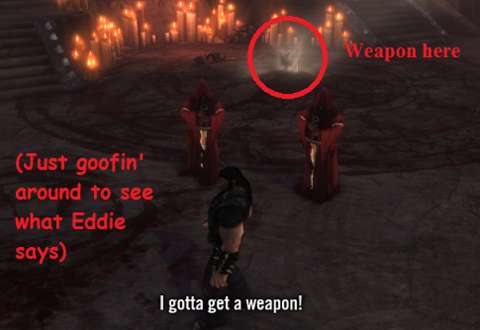
Most other tutorials in the game will be structured in such a manner. However, the game will not mention everything to the player.
ATTACKING & DEFENDING:
For whatever reason, Eddie is not a stranger to realizing what a “weapon” is, even though he presumably had a former life as a roadie.
Anyway, there is still a (very, very good) reason for him to simply pluck out a severe-looking weapon from a crack in a shrine, and then subsequently use it with unexpected skill to despatch a trio of unfriendly persons.
Soon enough, the player learns the simplicity of the “Separator”. The player can mash the attack button to make repeated attacks with short animations, or choose to spend time making Eddie vulnerable in order to charge up an unblockable attack; there are enemies who can block the default mashers, so this will be indispensable.
Alternatively, Eddie can hold up his axe, being somehow capable of blocking any low-level attack from any direction. However, wiser players would opt to reposition Eddie elsewhere instead. After all, player characters move very quickly in this game and they are far better being somewhere else rather than staying at one place for too long.
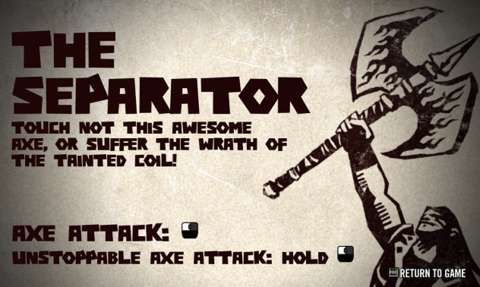
KILLING ENEMIES WITH MUSIC:
In the otherworldly dimension which Eddie is tossed into, music has tangible power – something that Eddie quickly realizes when he strums away on his guitar, affectionately named “Clementine”.
By merely having the camera centred on an enemy and strumming away at the guitar, the enemy is struck from bolts out of the blue. Making a longer rev causes the enemy to be launched up into the air with a burst of flames. There are other moves which make use of the guitar.
However, the guitar eventually builds up heat and becomes too hot for Eddie to use. This is, of course, a system which was put in place to prevent over-use of this very convenient form of offense.
The other form of gameplay-affecting music, which is Guitar Solo, will be described later.
REGENERATING HEALTH:
The game resorts to a regenerating health system, not unlike what has been done for Call of Duty or Gears of War. When the player character’s health dips to dangerous levels, the screen is tinted red, accompanied by worrisome heartbeats. In hindsight, the game could have gone for a more sophisticated health system.
TARGETING:
By default, Eddie attacks the nearest enemy, specifically whichever one the camera is centred upon (i.e. whichever enemy the player is looking at). Alternatively, the player can have him “lock on” to a particular target. This focuses most of the player’s attacks on this particular target. It also forces the camera to focus on the target; so far, so familiar.
However, for whatever reason, dodge-rolling can only be performed while the targeting mode is turned on. This can seem a bit irksome.
Furthermore, Eddie can only seem to roll in four directions, at least for the keyboard and mouse setup. This is odd, considering that the game allows running in a direction diagonal to the camera, but not rolling.
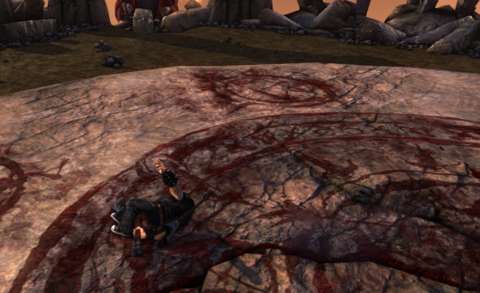
NO HOPPING AROUND:
There is no dedicated button to have Eddie jump. He will jump in order to perform some other actions, but there is no button which can be pressed to have him simply jump.
This might seem to be a minor issue, but there are actually many obstacles which could have been more conveniently circumvented by just jumping over them. This problem is already evident from the very first scene in which the player is given control of Eddie; Eddie cannot just jump down from the dais he woke up on, but instead has to go down stairs for that.
Of course, one can argue that Eddie eventually gets an ability which makes the lack of a jump button moot. However, until he gets in the story mode, the player has to make do with him running around. Moreover, this ability only seems to work in army-fielding scenarios in the story mode.
COMBOS:
Not long after the player has been introduced to the basics of using the axe and the guitar, the player is taught about combos, courtesy of Eddie’s incredible talent at learning how to utilize his tools for greater effect.
These combos are generally more powerful than Eddie’s basic axe swings or guitar zaps, though making full use of them requires some finesse and also observation.
For example, the Grand Slam has a long animation, and for killing just one enemy, it is not very efficient. However, it can be used to knock an enemy into another, though aiming is quite difficult.
Many of these combos require the use of the guitar; as long as the input sequence includes the control input for the guitar, the combo does make use of it. This also means that these combos will heat up the guitar, which is something to keep in mind.
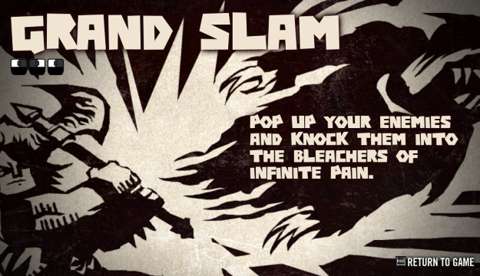
COMPANIONS:
In the story mode, Eddie Riggs won’t stay alone too long after his arrival in the other world. Soon enough, he comes across companions who will fight alongside him.
Companions who actually have names and unique models within the game are for all intents and purposes, indestructible. They may go down during fights, but are revived some time later. Only the story decides if and when a character dies permanently.
The companions either have their own unique combat capabilities or are based on the units which the player can later recruit. They can be attacked and can attack, but they likely will not be doing enough to turn fights around. Instead, the player has to intervene, either by diverting more friendlies into the fray, or having Eddie himself join the fight.
Most of the named companions happen to be lithe and light enough for the ridiculously muscular Eddie to hurl or haul around. In the former case, this can be used to launch a powerful attack against an enemy. Of course, this companion would be in deep trouble if this enemy remained alive afterwards.
In the latter case, such as when Eddie is letting Lars Halford perch on his shoulders, Eddie generally turns into a moving turret or whirling dervish of sorts, whereas his companions appear to obtain damage boosts from somehow riding around on his shoulders. In the case of Lars, he gets to use his heirloom sword to its full potential – incredibly wide swings.
There will be more elaboration on this ability of Eddie’s later, because it actually involves a gameplay element of having player characters work with other characters for powerful attacks.
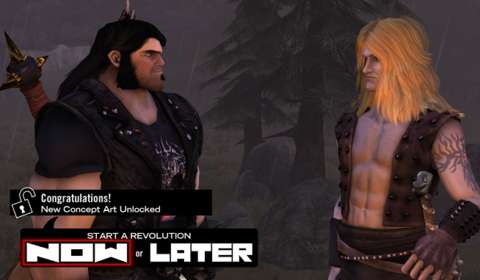
THE DEUCE:
The world which Eddie has entered into happens to be quite vast, and often quite dangerous to travel on foot. Therefore, there is the Deuce, which is a high-powered vehicle that Eddie cobbled together after finding relics of the world’s metal-oriented past.
In addition to being quite fast, the vehicle can run over most human-sized enemies, and later sports outrageous weaponry which makes it even more powerful. For example, its “secondary” weapon options include flamethrowers which are incredibly powerful.
However, to prevent the player from exploiting it too much, the Deuce cannot be used in many scenarios, such as for some story-related missions.
Interestingly, it will be very difficult for the player to attempt to kill friendly units with the Deuce. Collision scripts are disabled for when it collides with friendly units, and its weapons-fire simply passes through friendlies. This is handy, especially when the player is helping a patrol of friendly units handle a hostile patrol.
If there is a serious problem with the Deuce, it is that its controls are rather loose, especially when it turns without the use of the power brake. Fortunately, practice eventually lets a patient player get used to its controls.
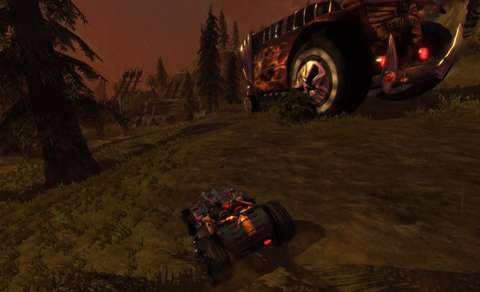
“ARMY”:
Brütal Legend is marketed as a blend of third-person action-oriented gameplay and real-time strategy (RTS). For the RTS segment, the player can recruit units which follow the player character around afterwards, waiting for orders. This part of the gameplay is not unlike that seen in the obscure RTS title that is Sacrifice.
To elaborate, recruits follow the player character around by default until the player orders the group to go somewhere or defend some place. There will be more on commands later.
It has to be pointed out here that the player cannot group units into groups which can be selected with hotkeys. Any command which the player character gives is automatically followed by any friendly units which are within range of hearing; this range of hearing is not depicted in anyway.
An RTS veteran who is used to point-&-click RTS games might have to take a while to learn this – assuming that he/she is not simply huffing off and dismissing this game as a mockery of “true RTS”.
Anyway, after the player has wrapped his/her head around this very simplistic system of orders, he/she can then learn about the other elements of “strategy” in the game.
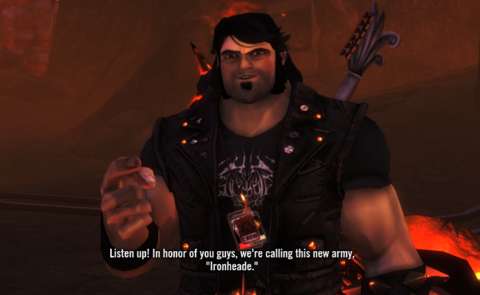
THREE FACTIONS:
Throughout the story mode, the player will be introduced to the three main factions of the game. The Tainted Coil is the first to be introduced, being a cohort of demons which is ruling the world like tyrants.
Later, the Ironheade faction is formed. Being canonically a motley crew, the Ironheade faction is officially the most familiar of the three, at least to anyone who played an RTS game before.
This is then followed by the Drowning Doom. They are a bunch of former people who condemned themselves by drinking deep from a source of power which is forbidden for good reason.
UNIT ROLES:
All three factions make use of unit archetypes which might be recognizable to an RTS veteran. For example, the Ironheade’s Headbangers are practically examples of the “grunt” archetype. Their counterparts in the other factions are the Drowning Doom’s Grave Diggers and the Tainted Coil’s Soul Kissers.
At a glance, their main differences lie in their statistics, which is not really saying much. However, the differences between them are revealed when the player makes use of the “Double Team” mechanic.
DOUBLE-TEAMING:
It has been mentioned earlier that Eddie can cooperate with certain named companions for powerful attacks. This is actually part of the Double-Teaming gameplay element, which is available to any player character.
RTS veterans would realize that this is the way with which the game implements its system of special abilities for units. Special abilities are a typical design trope in the RTS genre.
There are also some inconveniences too. For one, the player character has to approach one of these units in order for the double-team prompt to come up. This can seem a bit slow to execute.
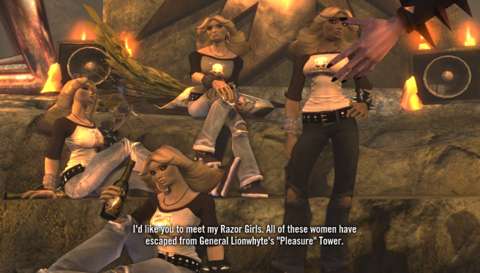
Yet, the special abilities can be amusing and effective at the same time. The manners in which they are used differ from faction to faction.
In the case of the Ironheade, this usually involves them hitching a ride on Eddie’s shoulders; Eddie’s sturdy body lets them perform powerful attacks, or Eddie just hurls them at the enemy. All of these abilities are over-the-top, sometimes literally, but they have benefits which are tactically useful.
In the case of the Drowning Doom, Drowned Ophelia (the player character for this faction) cavorts with the units or otherwise makes use of their quirks. For example, Ophelia can carry around one of the Frightwigs, which she can then toss onto an enemy who will then be possessed and turned to her side.
In the case of the Tainted Coil, Doviculus (the player character for this faction) uses Double-Team in a more unsightly manner with what are called “Hierarchy” units. This is needed in order to make lesser units, which Doviculus can then double-team with in order to perform powerful feats – usually to either his detriment or the units’.
For example, Doviculus can mount the Heart Cutter and let himself be stabbed in the heart. This results in a far more powerful attack from the Heart Cutter, replacing its default attack. Obviously, the player cannot repeatedly use this too much.
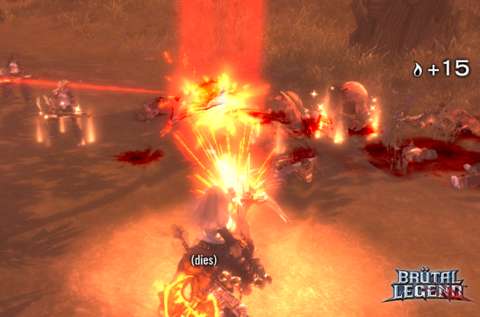
SIMPLE COMMANDS:
The player might want to divest himself/herself of any notion that this game is a sophisticated RTS game; it is not. In fact, it has closer in common with Sacrifice than any RTS title which has been inspired by Warcraft, Command & Conquer or even Ground Control.
The commands which the player character can give to units are very simple. Firstly, there is the important “Follow”, which has any nearby units within earshot stopping what they are doing in order to follow the player character around.
Next, there is “attack”, which sends any units which are following the player character towards any location which the player is looking at. It is not precise, but it is adequate if the player wants units to focus on certain locations in general.
Then, there is “defend”, which orders units to guard an area. This command would have been adequate, if not for the fact that units which have been set to “defend” will immediately obey commands which the player character makes within earshot and stop “defending” a location.
TIME-CONSUMING SPECIFIC COMMANDS:
The aforementioned commands can be given to specific units in a mob. However, it requires having to hold down a button while staying close to said units and then giving an order while still holding down that button. Any units of the same type within sight are selected for direction, but commands have to be given on the spot; moving away deselects the units.
In practice, this is too tedious to perform when the player is trying to manage a heated battle.
UNRULY UNITS:
If the rather simple commands do not suggest so already, the player will realize through other observations that all units in this game are next exactly professional soldiers.
If they are told to assault an area with enemies in it, they pick their own targets. For example, grunt units usually target other grunt units first, or archer units in the absence of the former. Unless told to focus their attention on a specific target, they will follow these routines.
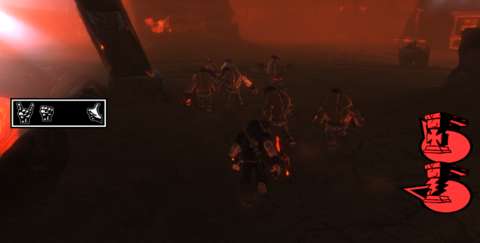
The units are not always efficient when left to their own devices. However, considering the themes of the game, battles turning into anarchic brawls are hardly inappropriate.
GUITAR SOLO:
In Brütal Legend’s world, there are a few individuals who are capable of creating music. This is just as well, because during the Metal Age, music creates tangible power which can heal or harm.
It so happens that the leaders of the three factions are capable of making miracle-creating music. To utilize this music, the player has to play a button-pressing mini-game.
Some players may not like having to press buttons in order to activate what are essentially the special powers of these individuals. Furthermore, the camera is stuck looking at the player character while this mini-game is being played. The player character is also vulnerable to attacks in this state.
Yet, these powers can be devastating when used at the right moment. The time needed to play the mini-game and the need to play it right balance this potential. Also, just in case the player is getting too comfortable with the button inputs (they are always the same for each solo), there is a cool-down time too.
As for the powers, these include area-of-effect attacks which can ruin entire swathes of low-level units, or spells which summon powerful vehicles which the player character can operate in order to quickly access some heavy firepower.
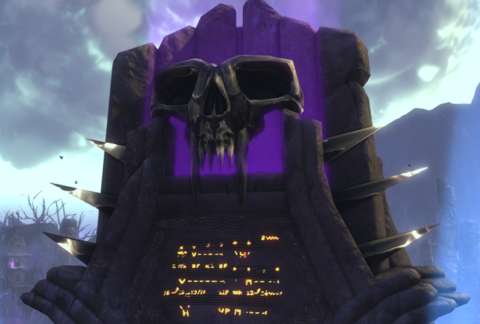
RAISING STAGES & ARMIES:
Thanks to a clever plot element, Eddie and friends discover that making music and shows grant great power. Stages which are dedicated to making music can attract the attention of otherworldly spirits, which Eddie somehow identifies as “fans” rather quickly. These spirits can flow into the stages, which can then fuel the raising of armies.
(Narratively speaking, it is not clear how this can help raise armies. However, it might be resurrecting them instead of raising them, if one considers the limitations on army sizes and the convenience of revival if the player character gets taken out.)
Anyway, with enough energy from the “fans”, the player can raise armies. The player starts with some basic units, but can upgrade the stage to gain access to more specialized units. Upgrading the stage also allows the upgrading of earlier units so that they remain competitive. (There will be more elaboration on the stage later.)
FAN GEYSERS:
Fan geysers are critical to any strategic plan. However, getting energy from the fans is not as simple as impressing them.
The geysers start out unaligned. To capture a geyser, the player has to play the “Fan Tribute” solo next to it. Afterwards, an immense “merch booth” builds itself around the geyser and it is claimed for the player’s side.
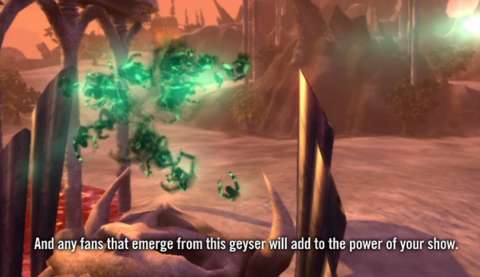
However, if the booth is destroyed, the geyser’s ownership is reverted to neutral. As long as there are opposing enemies nearby, the geyser cannot be reclaimed; neither can the enemy claim it as long as the player’s own forces are nearby. Due to this, battles to claim geysers can be quite heated; the losing side is likely to continue fighting anyway, if only to stall the winning side until reinforcements come.
Interestingly, claimed fan geysers are especially spiteful towards the leaders of other factions, pushing them away when they get too close. This is likely in order to prevent a player from simply overwhelming a geyser with his/her player character. Of course, the player can just have units do the deed instead, or to be more efficient, make use of Double-Team attacks.
THE “MEGASTAGE”:
Similarly, the player’s (very massive) show stage is quite averse to the presence of the other leaders. This is just as well, because having an enemy leader whacking away at the stage would have been very worrisome. However, just like what they can do to merch booths, they can still attack it from afar with Double-Team attacks.
By default, any units which the player “recruits” will appear in front of the stage, set on defend duty. The player will need to go back to the stage in order to obtain units, unless he/she uses certain guitar solos that call units to his/her location from anywhere in the map.
(However, they will still need to make the journey over ground, which can leave them vulnerable to attacks.)
Losing the Mega-stage means a straight loss. However, the player can repair the Mega-stage, but has to use fan energy to do so – fan energy which could have gone elsewhere. Therefore, it is in the player’s interest to keep the enemy away from the stage as much as possible.
If the player has units coming in from the stage, the player character can Double-Team with the stage, using its speakers to blast away enemies which are too close. This will not stop ranged units of course.
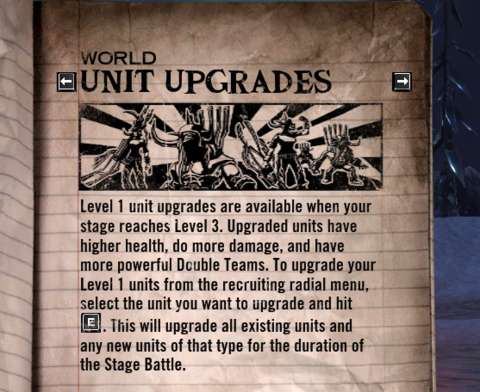
FLIGHT:
All player characters have the capability to fly. With just a tap of a button, the player character jumps up into the air. However, the player character is all but defenceless while flying; this is mainly because some of the control inputs for combat have been replaced with controls for flying, whereas the rest are mostly disabled.
On the other hand, the mobility and height vantage is much needed for the purpose of keeping an eye on what is happening in the battlefield.
It is also worth noting here that the flying mechanism reveals that the range of giving commands is not three-dimensional, but rather it is based on horizontal distance.
Flying, however, is not an always-available option throughout the story mode. For most of the story mode, Eddie must move on foot or drive around in the Deuce in order to get anywhere.
BEACONS:
The gameplay element of flying is associated with another element, which is the feature to place down beacons.
This is analogous to the act of scrolling about a battlefield and setting down waypoints in traditional RTS titles. Of course, it is far more primitive in comparison.
Anyway, once a beacon has been placed on the map, the player can send units over to that marker just by looking at it and giving commands. To use markers more effectively though, the player character must be flying.
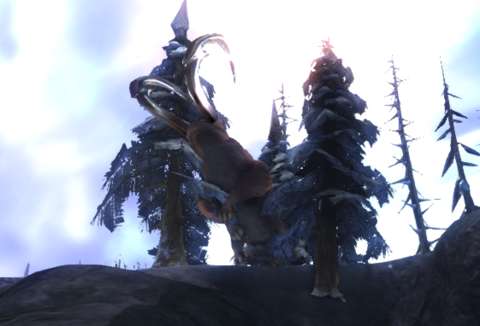
EXPLORATION – OVERVIEW:
The world in the Metal Age has many secrets to find. This is revealed early on in the story mode when Eddie somehow instinctively knew what to do when he found shrines which hold relics of earlier ages.
There are also many strange but awesome sights to see, such as the mountain of skulls and bones, the summit of which Eddie appears on.
In the story mode, the player can have Eddie exploring the world, preferably with the Deuce, in order to uncover more secrets and savour more sights. This grants unseen “Fire Tributes” unto Eddie, who can then cash these in with the Guardian of Metal (played by Ozzy Osbourne) for upgrades to his existing equipment, as well as cosmetic options.
Thus, the gameplay element of exploration is tied to a progression system which only appears in the story mode. Players who are already a bit jaded with progression systems might still find the act of exploration enjoyable though; Double Fine has invested a lot of effort into making Brütal Legend’s world seem convincing, and it shows.
There will be more elaboration on each notable element of exploration shortly.
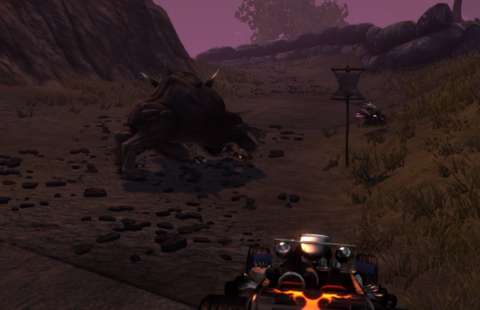
HEAVY METAL MONUMENTS:
There are monuments to the older Ages which have sunken into the land. With the Relic Raiser guitar solo, Eddie can raise them to get some easy Fire Tributes. They also grant new songs to play while driving around in the Deuce.
SWEET JUMPS:
The world has some warped roads and terrain which curiously ends with ramps. Near some of these ramps, bright bug-like creatures flit about, waiting for a dare-devil to make jumps using those ramps. The Fire Tributes which they give are worth more than those given by Monuments; of course, making these jumps requires some work, e.g. lining up the Deuce.
LANDMARKS:
The world of the Metal Age has many over-the-top but impressive sights to look at. One of them is the Ironheade’s home, the pit-like Bladehenge with its majestic monument of a gigantic sword.
There are others to look at, as are hinted by the presence of hideous-looking landmark viewers which happen to be (more or less) directed at landmarks. Upon using them, the camera pans to give panoramic views of the landmarks to the player.
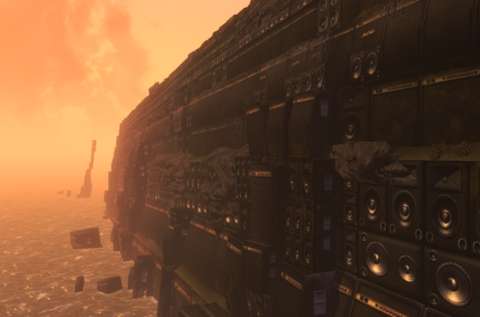
TAB SLABS:
The most immediately useful stuff to be found from exploration is “Tab Slabs”. These are plaques which Eddie can somehow transcribe in order to learn new Guitar Solos. Incidentally, they often appear where the powers which they grant will be rather useful. They also happen to be quite easy to spot, compared to other objects.
BOUND SERPENTS:
Bound Serpents are also known as Dragon Statues because Eddie refers to them as “dragons”. In-game, they act as collectibles of sorts. Every Bound Serpent which is freed grants very little fire tribute, but their true worth is that for every ten of them which are freed, Eddie gains bonuses to his health, flight speed, health regeneration and even area-of-effect healing for nearby friendly units.
However, there is a problem about them. It is that it is not clear how the player can free them; the game will not provide the player with a tutorial about releasing one, unlike the other exploration rewards which had been mentioned already.
Anyway, to release them, the player needs to light the statues on fire. Yet, only two powers are known to work at doing so: the guitar’s Pyro attack, and the Powerslide. In addition, the player must target the statues before using Pyro.
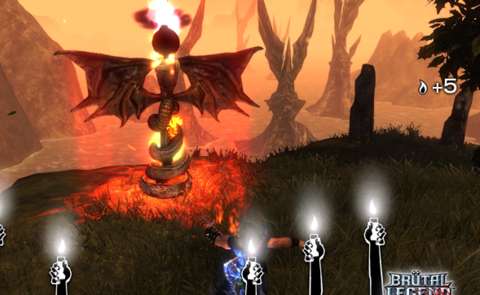
LEGENDS:
A similar complaint can also be made about “Legends”, which are edifices not unlike Bound Serpents. The player is also not informed of the means to unlock them; the player only has Eddie’s remarks for hints, and his remarks are not exactly useful in hindsight, after the player has figured out how to release Legends.
Anyway, Legends, as their names suggest, provide the player with backstory about the Metal Age and earlier times. They are not needed to make sense of the story’s progression, since the basics are already mentioned through that, but they fill in most gaps for inquisitive players.
METAL FORGES & UPGRADES:
Metal forges are like other relics; they have to be raised. However, after they have been raised, the player can have Eddie drive the Deuce into them to meet the Guardian of Metal (played by John Michael Osborne of Black Sabbath).
Upon having met Eddie for the first time, the Guardian of Metal is immediately impressed with Eddie. He is an affable person and is apparently a major fan of metal, even though Ozzy Osborne’s drawling voice typically disguises his enthusiasm.
Anyway, the Guardian of Metal knows a lot about the gear which is in Rigg’s possession. He holds back those secrets until Eddie has earned himself enough favour from the Gods of Metal, i.e Fire Tributes. Interestingly, no one else other than Eddie knows about him.
In terms of gameplay, he’s just a vendor for gear upgrades and cosmetic options, some of which might seem underwhelming to the jaded player.
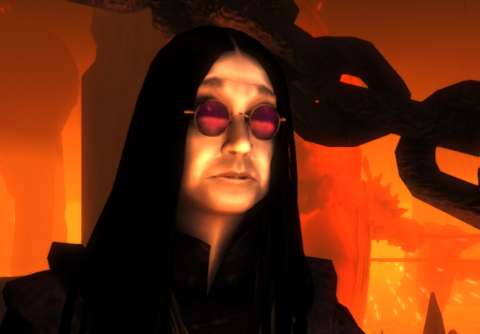
For example, there are some options for the Separator axe, but they are merely alternative buffs which are applied to the axe’s attacks. They do not radically change how it behaves.
Some of the others are much more useful though, such as more combos for Eddie to use.
The cosmetic options are perhaps a bit amusing, even though they have next to no gameplay consequences. Also, at least the Guardian of Metal makes remarks on the player’s choices – few others, if any, will anyway.
ENEMIES IN THE STORY MODE:
The player will of course be fighting enemies throughout the story mode; Eddie’s story is very much written in blood.
These enemies include members of the other two aforementioned factions. This might help the player in multiplayer matches, if he/she uses the Ironheade faction. (As a side note, the player could have benefited from experience playing as the other two factions in the story mode, but this would have been difficult to implement in the story.)
The player will also be fighting some other enemies which are not from the other factions. Some enemies are practically Ironheade units, such as those which fight under Lionwhyte’s banner. Then, there are some monstrous creatures, which are not aligned with any of the factions but are still deadly inhabitants of the Metal Age.
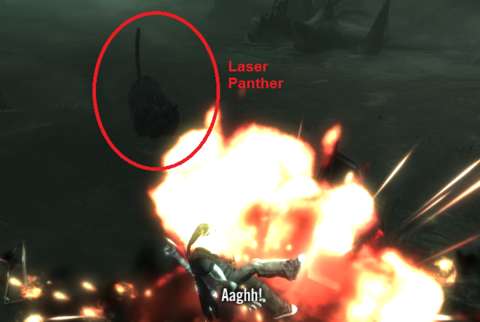
Enemies in the story mode happen to occur as patrol groups which belong to one of the opposing factions. The player can gain some Fire Tributes from annihilating a patrol, which is something the game does not inform the player about.
Anyway, if the player considers this design against the other methods of obtaining Fire Tributes, this is a “renewable” method. This helps if the player wants Fire Tributes but does not want to go around the world of the Metal Age to look for things.
There is also one “boss fight” in the game, though it is a rather formulaic one. It is easy if the player can keep in mind what powers Eddie has accrued up until the time to fight them.
STORY MISSIONS:
The story mode is composed of a string of story missions, which track the progress of the Ironheade faction as it struggles against the tyranny of the Tainted Coil and the threat of the Drowning Doom. The first few missions are typically disguised tutorials about the fundamental elements of the gameplay and the uses of Ironheade units.
Eventually, they fall into a few overarching categories, such as real-time battles against an opposing faction (called “stage battles” in-game) or tense escorts of the Ironheade’s massive bus. There is also a lot of driving to-and-fro.
It can get monotonous, but fortunately, there are side missions and (the aforementioned) exploration for the player to pursue as palette-cleansers.
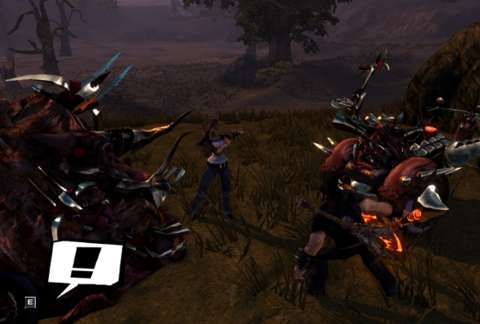
SIDE MISSIONS:
As the player progresses through the story mode, he/she unlocks other activities to pursue. These activities are more or less associated with what is going in the plot.
For example, after the player has reached the point in the story where the Ironheade faction has just been formed, the player gets to have Eddie partake in ambushes against Lionwhyte’s army, which starts appearing on the map as isolated patrols. Later, these ambushes turn into strikes against the undead of the Drowning Doom and the demons of the Tainted Coil.
Pursuing them does not appear to affect the main story in any way, however. This is implied in the side missions which have Eddie operating a turret.
Each side mission of any one type becomes noticeably a bit more difficult than the last one. For example, the ambush missions have enemy patrols becoming more and more powerful. The player might want to obtain more upgrades from the Guardian of Metal before attempting them.
Some of the side missions can seem a bit too bland for jaded players. For example, there are side missions where Eddie has to mount and operate turrets. Of course, one can argue that these are at least a bit different from the turret sequences in so many other games; there are friendly forces which the player has to protect, and in turn they protect enemies from getting too close. The turret cannot hit anything right underneath it.
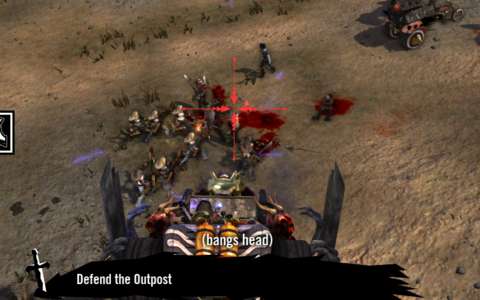
RACES:
A sizable number of these side missions have Eddie challenging Fletus, a demon who is particularly avid about racing (and who may well be a reference to Glottis of Grim Fandango). With each race the player wins, Fletus’s vehicle, the Squealer, somehow becomes faster and more powerful, easily beating the Deuce if the player has not bothered to upgrade it.
However, with enough cunning and deft handling, the player can stave off purchasing upgrades. This is because Fletus always follows a set path, more or less, whereas the player can have the Deuce taking small but risky short-cuts here and there.
Of course, to prevent the player from simply cheating, the Deuce has to follow a blue pillar of light, though not very closely.
As for the race “tracks”, they are actually part of the game world. It is not immediately clear that the game world has been designed with races in mind, especially if the player looks at the scenery along the tracks and the off-road paths which the races often occur on. However, the tracks are doable, and it will not take much practice to figure how where to put a little more distance between Eddie’s Deuce and Fletus’s Squealer.
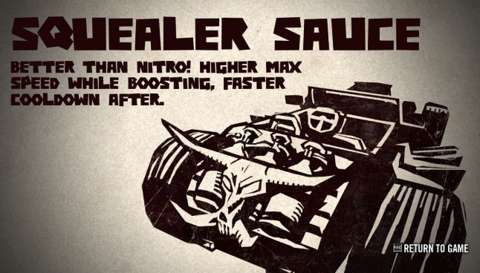
Interestingly, some of the race tracks start at the beginning of paths which the player needs to go back along later on in order to reach other side missions. For example, there is one which has the player racing through a snowy gorge. When this convenience occurs, it is very much appreciated.
If there is a problem with the races, it is that Fletus’s ride appears to have immense mass. There is no way that the Deuce can shove it around, but rather the Deuce gets shoved around instead if the Squealer gets too close. Perhaps the immense mass was intended so that the Squealer is not derailed from following its path, but this is an unpleasant side effect.
CHARACTER DESIGNS:
That this game is a Double Fine product may not seem immediately noticeable. After all, Double Fine has generally made mostly family-friendly games; Brütal Legend is obviously not.
The characters make this known almost immediately, usually through their cussing. Indeed, Eddie himself is a bit potty-mouthed, usually hilariously so.
Being a game which is about the darker and grimmer aspects of metal culture, just about everyone in the game is used to the presence of clearly inhuman things. The character which is most exemplary of this is Eddie Riggs himself. Despite having been tossed into a realm which is obviously not the one which he came from, he fit in almost immediately.
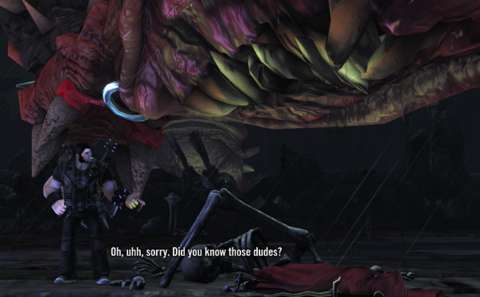
There could have been many moments in the story where its delivery might have been cheesy due to the characters. For example, Lars (voiced by Zach Hanks, an employee of audio company Precision Talent) has a lot of melodramatic lines. Fortunately, thanks to the skill of Double Fine’s writers, these moments are not too overbearing.
Using the example of Lars again, the writers are aware that he does not exactly have much contribution to the story beyond giving the more important protagonists a reason to live for. Lars does not have many scenes in the game, and his scenes end quickly.
Most of the characters have personalities which are appropriately matched to whoever they are modelled after. Yet, there are a few exceptions, and they stand out like a sore thumb. An example will be described shortly.
Kyle Gass, who is Jack Black’s friend and member of Black’s band “Tenacious D”, gets a role in the game; this follows the informal tradition of Gass appearing in just about every film which Jack Black has a starring role in.
Like in almost of his other appearances, Gass is a potty-mouthed oddball. His character is amusing, of course, but mismatched to his character, which is one of the Bouncers. The Bouncers are rather dim-witted, so it is odd that Gass’s character appears to be a lot more mentally capable than they are.
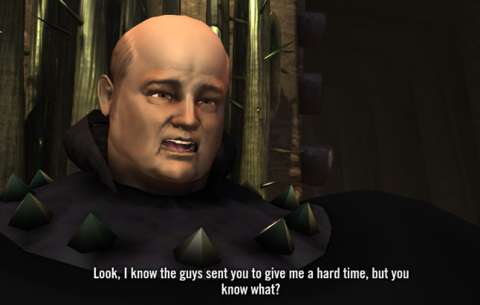
VISUAL DESIGNS OF THE METAL AGE:
The part of the visual designs of the game which Double Fine focused most on will be apparent almost from the start of the game.
The world in the Metal Age is one of imposing vistas, as mentioned earlier. Many of them look unbelievable, but impressive nonetheless; they might even endear themselves to ardent metal fans who have fantasized about a world where metal culture is pervasive and savage.
There are many humanoid statues which are making gestures and poses which are associated with metal culture. There are also plenty of monuments which pay tribute to demonic-looking monsters, not unlike those seen in artwork made by particularly imaginative fans of metal who believe that metal culture is grim but stylish.
Perhaps it might have seemed disingenuous too, but it can be said that Double Fine made a wise decision in making landmark views some of the collectibles. (It might not have placed the locations for the viewers at believable locations though.)
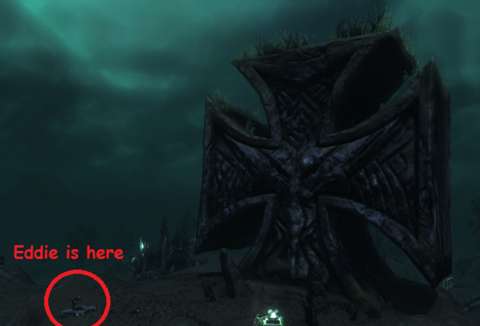
VISUAL DESIGNS OF CHARACTERS:
Other than the obvious use of the likenesses of metal celebrities, humanoid characters have cartoonish bodily proportions, as to be expected of a Double Fine game. Eddie Riggs himself is an example, being incredibly muscular (though there are far more muscular characters in the game, such as other roadies).
Speaking of which, muscular characters sometimes look odd because of the unbelievable twisting of their polygons when they move their body parts about.
Double Fine wants all characters to be exaggerated portrayals of ardent metal followers who dress themselves up in garish yet severe-looking get-ups. Therefore, the characters in this game, all of whom treat metal with a near-religious fervour, have accoutrements which one usually sees on die-hard metal fans who want to look the look as much as they want to talk the talk.
(Of course, these accoutrements are actually bloody instruments of battle in this game.)
That almost everyone has fabulous hair is also notable. However, their hair billows more than it flows, which makes them seem unnatural. There is also a lot of model clipping involving their hair, making them look even more unconvincing.
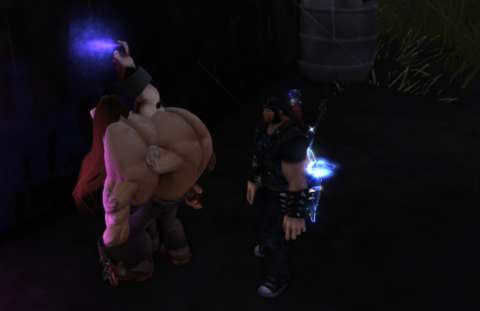
There are other visual designs for character models which would not be mentioned here, for the sake of brevity. It should suffice to say though that Double Fine’s artists were convincing in their efforts, but the animators and programmers do not exactly exhibit the same dedication.
PARTICLE EFFECTS:
Having obtained the opportunity to remake the game for the computer platform, Double Fine has made use of some snazzy graphical effects, such as lots of bloom. This can be seen from the copious particle effects in the game. There are blood sprays, lightning arcs, fire embers and such other similar graphics.
LIGHTING AND SHADOWING:
Unfortunately, Double Fine’s Buddha engine is not exactly well-suited to making believable shadows. Rather, the game uses filters in order to illuminate models. It also uses pre-set lighting and shadowing for much of the environments in the game.
The good news is that the lighting for the changes in the time of in-game days is quite impressive. For example, dusk and dawn reward the player with brilliant views of the sun in the backdrop.
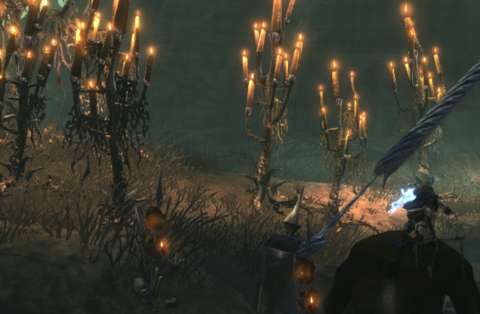
SCREEN-OBSCURING MISSION STARTS:
Most of the game’s visual designs are welcome – except for a few.
The least appreciable of these is the odd stencil-like visual effect which is applied to the screen when the player has just started any mission. This visual effect obscures much of the player’s view.
As if this is not enough, there is a grainy filter which is applied to the rest of the screen which is not obscured. This filter overrides other visual effects, such as highlights of targets.
These visual designs would not have been an issue, if not for the fact that the game continues when they are still obscuring the screen. This can be a problem if the mission is a time-dependent one, or otherwise necessitates urgency; in the case of such a mission, the obscuration of the screen is detrimental.
VOICE-OVERS:
Being a star-studded game, there are plenty of celebrities who lent their voices to the game. The quality of their performances varies, but generally, the characters who matter the most benefit from the most enthusiastic and/or skilled of celebrities.
The most prominent of these is of course Jack Black, who takes eagerly to his role as Eddie Riggs. Hearing his character make jokes, amused remarks or bungle through awkward encounters is very entertaining.
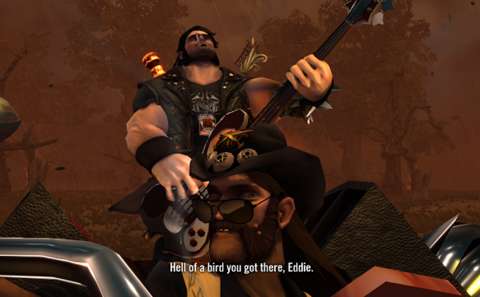
Many of the celebrities who lent their voices to this game are metal enthusiasts. For example, Killmaster, whose name is actually an oxymoron in-universe, is voiced by Ian Kilmister, who is the front man of the metal band Motörhead.
Not all of them are talented at voice-acting, obviously, but surprisingly, there are very few examples of noticeably poor voice-acting. Even the almost-sleepy performances by Ozzy Osborne and Ian Kilmister sound convincing.
MUSIC:
Being a game which is a tribute to the music category that is metal, there are a lot of metal songs and tracks in the game. Many of these songs are associated with the metal hey-days of the 1960s, 1970s and 1980s, though metal fans would argue that they are timeless.
As for the bands which composed these songs, they include groups which would be known to any metal fan worth his/her salt: Black Sabbath, Motörhead and Narita, among others.
The songs which are associated with bands are mainly for the driving segments; they are seldom heard elsewhere. This is just as well, because driving can become boring if the player is merely going from point A to point B.
Even so, there are moments when the player might want to mute the Deuce’s music player so that he/she can listen to the ambient sounds of the environments.
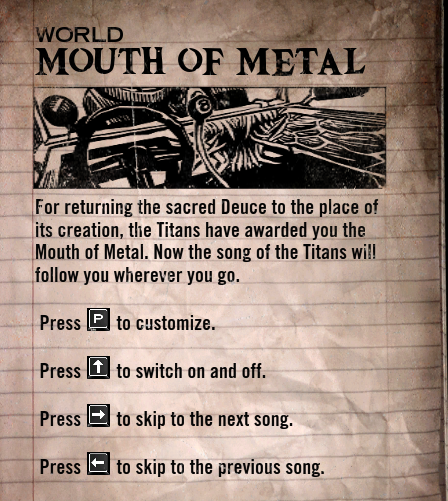
Fortunately, there is not any aural design to the gameplay element of exploration; most of what the player needs to find can be found by looking around meticulously. Therefore, the player can listen to the tracks while driving the noisy Deuce around.
However, not all songs and tracks are available to listen to right from the start. Rather, the player needs to raise relics in order to unlock more tracks.
SOUND EFFECTS:
The music and voice-overs are the most prominent sounds in the game, but there are other sounds to be heard too, specifically the sounds of combat.
For example, there is the roar and crackle of fire and lightning, especially when Eddie Riggs is involved. As another example, if the Tainted Coil is involved, there is often the noise of churning liquid, due to the Coil’s use of noxious weapons.
There are few sounds to be heard from the environments though. There are locales such as the Screaming Wall which do have some, but most other locales are relatively silent and they depend more on ambient music for their aural presentation.
STEAM-ONLY MULTIPLAYER:
Unfortunately, players who want multiplayer experiences without any third-party infrastructure would be disappointed with the computer version of Brütal Legend. This is because playing with other people can only be done through Steamworks.
To elaborate, both ranked matches and custom match-making are performed through Steamworks’ facilities, and only after the player has registered the game with his/her Steam account.
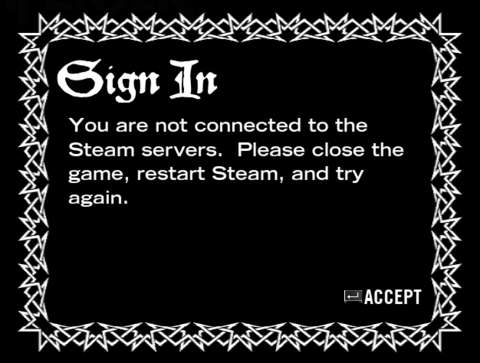
This can seem annoying to players who had purchased the Humble Bundle version of the game. Of course, the Steam redemption code came with the purchase, but this version of the game is supposed to be DRM-free.
“AI PRACTICE”:
The need for Steamworks leaves the player who just does not want to use third-party infrastructure with only one avenue for “multiplayer” matches: ‘practice’ with the AI.
Perhaps Double Fine’s designers have realized that the “AI” which they have made is not exactly sufficient for the purpose of providing an adequate challenge to a veteran of strategy games, so they have used the word “practice”.
Anyway, the computer-controlled opponent which the player faces knows enough about the gameplay elements in the strategy segment of the game; it will capture geysers, raise armies and use Double-Team attacks where it is advantageous to do so.
However, it is not very good at maintaining pressure against the player. A player who is aggressive and mindful of bringing in and directing new assets to where they are needed can easily outmaneuver the computer-controlled opponent.
A COMPLAINT:
Despite the vast-looking game-world which Double Fine has made for the story mode, the game does restrict the player to pre-defined areas, which are usually depicted by obvious obstructions, such as physical barriers. However, there are some missions where these obstructions are missing.
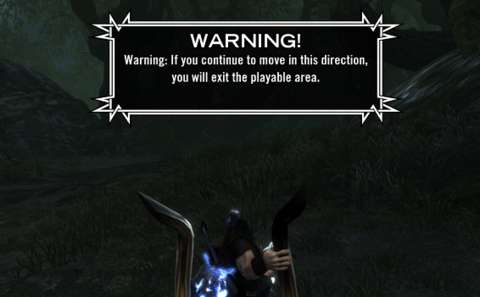
Instead, the game resorts to an immersion-breaking work-around: if the player attempts to move out of the areas, the player gets a warning message.
ANOTHER MINOR COMPLAINT:
The game makes use of a checkpoint system to record the player’s progress. Checkpoints are placed at the start of missions and the Metal Forges. Unfortunately, these are not enough to facilitate the exploration of the world of Metal. More often than not, when the player returns to the game for another session of the story mode, he/she might have to start at a Metal Forge, which may or may not be close enough to where he/she wants to go.
YET ANOTHER MINOR COMPLAINT:
One of the side missions happens to be bugged. This is the conclusion of the Overslaughter activity, which has the player killing wildlife.
Back in 2009, in the console version of the game, the only problem to be had was the missing marker for the Hunter’s location after completing the last wildlife hunt. In the computer version, the Hunter is simply missing from his last known campsite; he is not at his other camp either, in the mountainous Death’s Clutch.
Presumably, this bug occurs after a certain point in the story, where the Ironheade’s original homeland has been overrun. Again, presumably, the player has to cleanse their homeland in order for him to return. This is just conjecture, and even if this is true, the player could at least have been informed of this.
Granted, this side activity is not critical to the gameplay. Yet, there is the impression that Double Fine had not been very thorough with porting the game over to the computer platform.
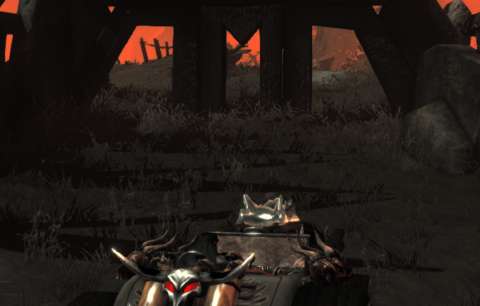
SUMMARY:
As to be expected of a Double Fine game, Brütal Legend has a lot of witty entertainment to offer. Its blend of third-person action and real-time strategy is not particularly sophisticated, but it is enough to provide a functional and exciting experience (assuming that the player is not already prejudiced against the gameplay for its lack of ground-breaking ideas).
The game is not without its flaws of course. There are a few loose ends in its gameplay, especially those which are not critical to the gameplay. There are also a few minor visual bugs. All of these strongly suggest lack of thorough quality control. This happened despite the game having been placed through development twice, the second time of which is for the porting to the computer platform.
Nevertheless, if Brütal Legend was intended to be a metaphorical love letter to metal, then it is an amusingly written one, with the kind of wit and oddball presentation which is Double Fine’s much-adored trademark.

